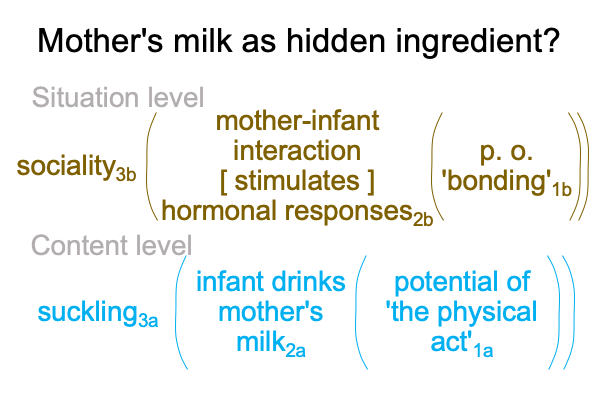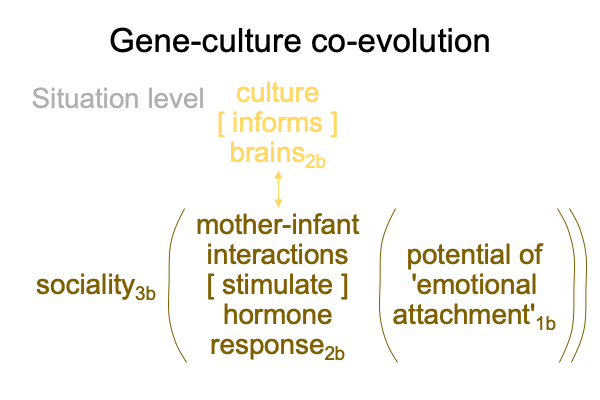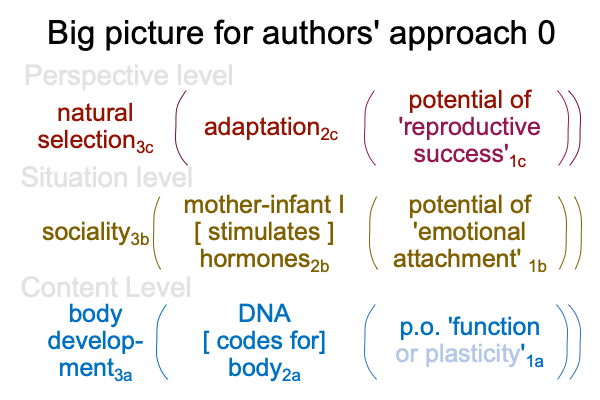0021 The authors’ focus on actuality2, rather than potential1, is typical for modern sciences.
There is an alternative to the two-level interscope for gene-culture co-evolution. The alternative has the same situation-level nested form, but a different content level.
To start, genes2a are a content-level actuality2a, corresponding to DNA [codes for] brains2a. Culture [informs] brains2b is a situation-level actuality2b that emerges from… um… the potential ‘situating content’1b. But, does that situation-level potential1b virtually emerge from (and situate) the potential of brain function or plasticity1a? Or, does it1b virtually situate another potential, such as the potential of ‘whatever is happening at the time’1a?
0023 Is there a hidden ingredient to gene-culture co-evolution?
That hidden ingredient is expressed on the content level of the following two-level interscope.

0024 Now, this hidden ingredient must be very important for the “sauce” of the story that Newson and Richerson tells.
It is as if culture informs brains2b allows the creature to fill in the blanks on the content level.
0025 But, I suppose before our lineage has big brains, then that content level is not culture oriented. Something much more… um… primal tells the story.
If I go back to a common ancestor between the chimpanzees and our lineage, say seven million years ago, then that obvious actuality2a involves a behavior common to all mammals.
Chapter two begins with an interlude, a story about mother-infant “culture”. When the infant drinks its mother’s milk2a, the mother-infant interaction stimulates hormonal responses2b.
0026 Here is the hidden ingredient two-level interscope for mother-infant interactions.

0027 If the situation-level normal context is sociality3b, then the potential of situating content1b could be called, by psychologists, the possibility of ‘an mother-infant bond’1b.

0028 Mother-infant bonding1b situates the physical act of the infant suckling2a, which is innate for mammals. So, the content level for the hidden ingredient dovetails into the content level for gene-culture co-evolution.

0029 The normal context of suckling3a can be viewed as a facet of body development3a.
The infant’s behavior2a must be genetic2a, since an infant is too young to culturally figure out anything.
The innate physical act1a has a function1a, so plasticity offers no advantage.
0030 What does this imply?
The secret message of the hidden ingredient of the “gene” side of gene-culture co-evolution is that our brains have the potential to construct the hidden ingredient. A content level2a obviously must be going on when content is situated1b in the normal context of sociality3b. So, the potential of function or plasticity1a corresponds to the (innately gifted) ability of the individual to isolate the potential of ‘whatever is happening at the time’1a, as well as the normal context3a and the actuality2a of the hidden ingredient.
0031 How complicated is that?
There is a huge advantage to Newson and Richerson’s theoretical sleight of hand. The situation-level actuality2b arising from mother-infant bonding1b has the same hylomorphic structure (of two contiguous real elements) as culture [informs] brains2b. Indeed, one may say that these two dyads are the polar ends of a continuum of behaviors that rely on pure function (for stimulation) at one end and pure plasticity (for information) on the other.

0032 Finally, the authors complete their picture by claiming that the emotional attachment1b increases reproductive success1c.
The problem?
The potential for ‘reproductive success’1c is necessary, but not sufficient, to explain the actuality of an adaptation2c. A niche1 is required to honestly account for any particular adaptation2 in the normal context of natural selection3. However, the authors are not aware that humans have a niche or that the human niche may have anything to do with the hidden ingredient composing a content-level nested form that does not appear in their theoretical framework.
0033 Here is a picture of the authors’ big picture, applied to the last common ancestor of the chimpanzee and human.

